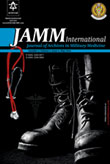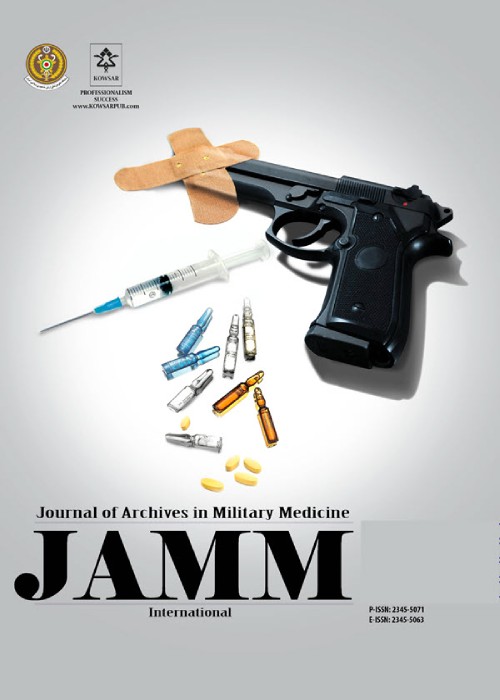فهرست مطالب

Journal of Archives in Military Medicine
Volume:2 Issue: 3, Aug 2014
- تاریخ انتشار: 1393/08/03
- تعداد عناوین: 7
-
Page 1BackgroundSetting Military recruitments to training programs intended for individuals wishing to work in the military, security or intelligence services is a very sensitive task. The identification of the applicants’ personality traits, skills and abilities constitutes an importance part of the recruitment procedure..ObjectivesThe present study attempted to identify the major characteristics the military force must possess, as well as the current candidates candidates'' suitability in terms of their personality characteristics..Patients andMethodsThe authorities at an Asian country army were interviewed in order to identify the major characteristics they believed to be necessary for the military personnel willing to work in that organization. Furthermore, 195 randomly selected students from a military training center in the same region were examined to reveal the extent to which their personality traits matched those specified by the experts..ResultsIt was observed that the majority of the students who were tested enjoyed a good status regarding personality traits relevant to the nature of the tasks they were to be assigned in the future. However, based on the participants’ scores on the NEO Psychological Inventory, Revised, some individuals were identified as lacking the needed personality traits and as a result, were not suitable for such responsibilities..ConclusionsThe obtained results indicated that the existing admission procedure was not efficient and needed to be revisited. More psychological tests and background checks need to be included in the admission procedure. In addition, a thorough needs analysis should be done in order to identify the major characteristics such applicants should possess in order to be successful in that profession after they are finished with their education..Keywords: Personality, Personnel Recruitment, Personality Traits, NEO Personality Inventory
-
Page 2BackgroundDental attrition is capable of causing toothache, temporomandibular disorders (TMDs), and vertical facial dimension loss. It may also harden prosthesis fabrication. The most frequent causes of this problem are stress and mental tensions..ObjectivesHowever, there is no documented or published data on the prevalence of dental attrition and TMDs among army personnel. Nevertheless, by timely recognition of the susceptible cases, it is possible to prevent or stop the development of this condition..Patients andMethodsThe participants were patients seeking general dentistry treatments in two military based centers in Tehran. Sample consisted of 200 army personnel and 200 civilian patients. All the participants were divided into three age groups: under 30, between 30 and 50, and above 50 years old. The examinations included dental attrition, temporomandibular joint (TMJ) click on opening or closing, limitation on mouth opening, pain on TMJ or chewing muscle or tenderness in palpation. The participants were also asked to declare whether they have contributed in the imposed war..ResultsDental attrition was significantly more frequent in army personnel than civilian population. Also the prevalence of such a problem was significantly more frequent in those participated at war. Considering other examinations, no statistically significant differences were seen between army personnel and lay persons..ConclusionsIn order to prevent or treat dental attrition in susceptible army personnel, part-time wear of night guard may be prescribed..Keywords: Tooth Attrition, Military Personnel, Temporomandibular Joint Disorders
-
Page 3BackgroundThere are three methods for procedural sedation in upper extremity traumas; systemic, regional and local anesthesia. There is controversy in the literature regarding the method of choice for this purpose..ObjectivesThe aim of this study was to compare conscious sedation and Bier’s block methods for pain reduction in upper extremity trauma patients..Patients andMethodsThis was a non-blinded randomized clinical trial. Patients were randomly allocated to either the Bier’s block or the conscious sedation group. Pain reduction was assessed by a numerical rating scale; patients, surgeons and physicians responsible for analgesia satisfaction were assessed using a five-point Likert scale..ResultsThere were no significant differences between the two groups regarding basic characteristics. Pain reduction was significantly more in Bier’s block group (P = 0.09). The most common complication in patients of the Bier group was pain in the tourniquet site (6 cases; 17.65%) and in the conscious sedation group this was nausea (11cases; 31.43%). The total number of cases with complications did not significantly differ between the two groups (P = 0.35). Surgeons'' satisfaction was similar between the two groups yet satisfaction of patients and physicians, responsible for analgesia, was more in Bier’s block group (P = 0.1 and P = 0.05, respectively). Although the amount of time needed for inducing sedation was more in the Bier group yet total duration of procedure in the Bier group was significantly lower than the conscious sedation group (P < 0.01). Decline in pulse rate and mean arterial pressure was more intense in the conscious sedation group indicating more hemodynamic instability (P < 0.01)..ConclusionsRegarding our results, it seems that Bier’s block works better for procedural sedation in upper extremity traumas compared to conscious sedation, when used appropriately for selected cases..Keywords: Conscious Sedation, Pain Management, Arm Injuries
-
Page 4Context: Toxoplasmosis is one of the most common parasitic infections worldwide and is occasionally able to cause cysts in the central nervous system (CNS). Although its importance is highlighted in immune-compromised patients, it is also associated with non-identified complications due to various anatomopathological and histological changes in CNS among immune-competent hosts, particularly following travel or military deployment to endemic regions. These changes may lead to behavioral disorders, which are frequently overlooked or misdiagnosed..Evidence Acquisition: We designed a narrative review to describe the risk of toxoplasmosis associated with military jobs and the potential changes in different parts of the central nervous system during toxoplasmosis, based on published articles in the last 30 years..ResultsThe current body of evidence reveals many potential routes of transmission for military operating forces and there have been several reports of toxoplasma outbreaks among soldiers. Although acute infection is frequently symptomless, many mild and non-specific clinical manifestations are commonly overlooked. Also, military forces are prone to CNS toxoplasma infections, which may lead to several psychological and neurological clinical presentations following acute, sub-acute and chronic infection..ConclusionsToxoplasmosis is frequent among military forces and CNS infection is likely in this population. Thus clinicians must be aware and investigate toxoplasma in suspicious neuropsychological manifestations even in immunocompetent and apparently healthy hosts, particularly for military personnel deployed to endemic areas..Keywords: Brain, Military, Toxoplasmosis
-
Page 5BackgroundBurns are one of the most common injuries in the world, most importantly during the wars, and the patients usually experience high levels of pain. Complications include both physical and psychological aspects as well as aesthetic concerns. Management comprises special strategies via specific treatment protocols. Treatment stages include: rescue and control of breathing rhythm, hemorrhage management, fracture closure, particle removal, infection control and control of body temperature. It has been suggested that laser therapy with low level energy could have a positive effect on wound healing process..ObjectivesThe aim of this study was to examine the effect of different wavelengths of Ga-As laser with blue (405 nm) and green (532 nm) wavelengths on the healing of third-degree burn wounds in Wistar rats..Materials And MethodsIn this study, 36 male Wistar rats (8-weekold, weighting 250-300 g) were divided into three groups of equal numbers. All animals were anesthetized by intraperitoneal injections. Dorsal hairs were shaved and third-degree skin burns were created on the back of the animals by using a copper stamp. The stamp was warmed up first to 95˚C via a heater. Afterwards, the animals were randomly divided into the blue and green laser and control groups. The length and width of each wound were measured by a caliper and the area of the lesion was calculated on the first, third, seventh, tenth, fourteenth, seventeenth, and twenty-first days of the study. Six samples were taken from each group for pathobiological analysis..ResultsA mild anti-inflammatory effect of blue laser was observed during acute phase, which could possibly accelerate wound healing during the first week of repair. Results of our study showed that using low-level laser therapy (LLLT) with green and blue wavelengths may accelerate the wound healing process as compared with the control group..ConclusionsThe laser groups have a significantly more rapid rate of wound contraction than the control group during the healing process of burns; however, the effect of LLLT on burn wound healing was neither statistically nor histologically significant. More studies should be performed to investigate other treatment protocols and prescriptions of soft laser to clarify its role in the treatment of wounds and burn injuries..Keywords: Laser, Wound, Healing, Burn, Injuries
-
Page 6BackgroundFunctional treatments are widely used and are generally the accepted treatment for ankle sprains. Regarding effectiveness, comparing different functional treatment options could not make definitive conclusions..ObjectivesThe objective of this article was to compare Taping Versus Bracing for Ankle Sprains injuries.. Patients andMethodsAll injured individuals with acute ankle sprains received standard advice (rest, ice compression with a compressive bandage, and elevation) at the clinic. After a week, 150 injured individuals with grade II and III sprains were categorized randomly into two groups: one group was treated with tape and the other with a brace for four weeks. Post injury training (proprioceptive and physical) was performed for the two groups. As first outcome parameters patient satisfaction and skin complications were assessed with an organized questionnaire and quantitative scale. As late outcome parameters, the function of ankle joint was evaluated with Karlsson quantitative scale and range of motion (ROM)..ResultsThe study group indicated that satisfaction and comfort during brace treatment increased significantly. A cutaneous complication in the brace group was significantly lower in comparison to the other group (16.4% versus 51.9%). The ankle joint function outcome and perceived pain was the same for both groups..ConclusionsTreating acute ankle sprain with a brace was accompanied with greater satisfaction and less pain with a similarly acceptable outcome when compared to taping..Keywords: Military Personel, Ankle Sprain, Athletic Tape
-
Page 7IntroductionDisease and nonbattle injuries are common among deployed military forces and musculoskeletal disease is a leading burden of disease in military population. Consequently, military employees and veterans frequency need medical and surgical management for lumbar disc herniation. Because of considerable complications and long post operation rehabilitation period, minimal invasive procedures have substituted old techniques in many modern military hospitals..Case PresentationIn this study, the preliminary results of 30 operated cases with the full endoscopic lumbar disc herniectomy technique in a military hospital were presented for feasibility, complications and follow-up outcomes. Disc herniation was more frequent in left side, particularly in L5-S1 level. Three patients from the first 10 cases were converted to open surgery. No important complication was observed and all patients were pain free, had no complication after 1 and 2 months follow-up and returned to their work..ConclusionsWe observed that the procedure is feasible and accompanied with an acceptable success rate, short hospital stay and very few perioperative and postoperative complications. It is an appropriate choice of treatment, even in combat region and moving hospitals and can reduce the morbidity of the disease..Keywords: Surgery, Endoscopy, Disc Hernistion


